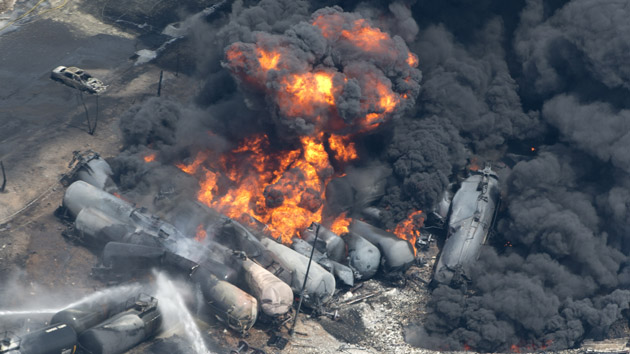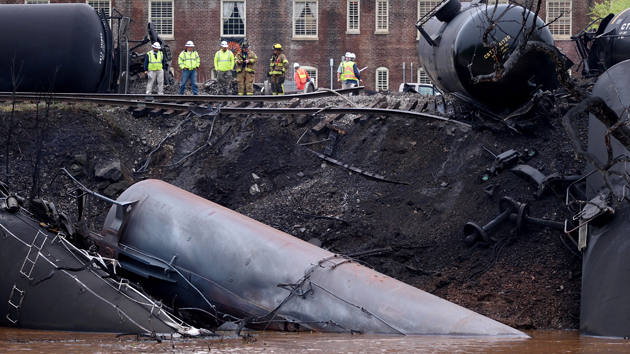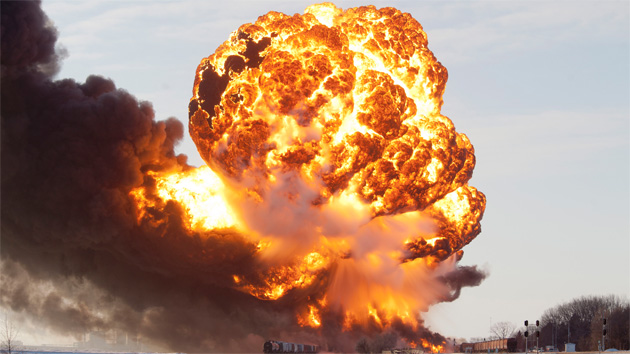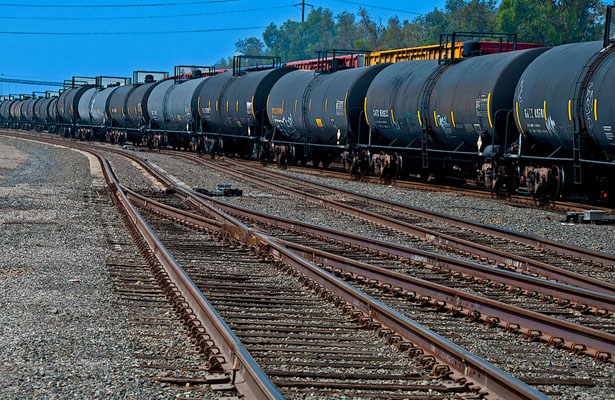There’s a strange corner of YouTube where train-spotters post their conquests in exhaustive detail. It’s one of the weirder YouTube holes I’ve been down in a while. But…oddly comforting. This video—of a Canadian National Railway locomotive making a meal out of snow drifts left by major blizzards in New Brunswick—is like something directly out of Snowpiercer, the 2013 dystopian ice age thriller set in a climate-altered future.
While certainly mesmerizing, there’s an important issue to note that has gone unremarked upon since the video went viral. It’s unclear what precisely the locomotive is carrying, but it’s definitely pulling tankers. Its cargo may very well be oil, given that its destination is St John, New Brunswick, the location of Canada’s biggest oil refinery, the Irving Oil Refinery. That refinery was the destination for the train laden with Bakken oil that derailed and exploded in Lac-Mégantic, Quebec, in July 2013. The Lac-Mégantic accident killed 47 people and prompted calls across Canada and the United States for tougher safety standards for the booming oil-by-rail network.
Mark Hallman, director of communications for Canadian National Railway, refused to give specifics about the types of cargo being pulled by the train in the YouTube clip, calling it a “mixed freight” service. But Jayni Foley Hein, an expert on energy and transportation at the Institute for Policy Integrity, says crude is one likely possibility. “Its carrying the type of tankers that generally carry oil, and given its proximity to this refinery, it’s certainly a reasonable prediction,” she said.
Despite the soaring plumes of snow, Hallman told me that the train in the video was “totally safely operated,” adding, “That’s winter in Canada. That’s what we have to deal with.” The railway’s own “Customer Safety Handbook” says that operators should take special care in wintry, snowy conditions: “Many of the service disruptions center on accumulations of snow and ice,” says the handbook. “On the track, snow mostly constitutes a problem in switches, as well as at crossings—so once the snow is cleared, the problem is solved.” In general, winter hits railway lines hard, contracting the tracks and making fractures more likely, according to Canadian National Railway.
A 10-year US Department of Transportation analysis of weather-related train accidents in America, from 1995 to 2005, found that the accidents related to snow and ice, when they did occur, often resulted in dangerous derailments. “During the winter months of December through March, the highest accident numbers arose from preexisting snow and ice conditions such as buildups that cause malfunctioning switches and derailments,” the report found.
After the Lac-Mégantic disaster, both the United States and Canada agreed to get rid of the older and more dangerous versions of the tanker involved in that tragedy, the “DOT-111.” (We covered the cons of this tanker extensively last May.) In mid-January, Canada announced it would take the tankers off the network years sooner than the United States will, putting the two countries at odds over increased safety measures on the deeply integrated system.
The dangers of carrying oil by rail have fueled a key aspect to the ongoing debate over the Keystone XL pipeline. When the US State Department issued its long-awaited environmental-impact statement on the project last year, one of its most significant findings was that if the controversial pipeline wasn’t built, oil-laden rail cars would pick up the slack. “Rail will likely be able to accommodate new production if new pipelines are delayed or not constructed,” it argued. (More recently, falling oil prices have led the EPA to question that line of reasoning.)
NBC recently reported that in America, trains spilled crude oil more often in 2014 than in any year since the government began collecting data in 1975.
















